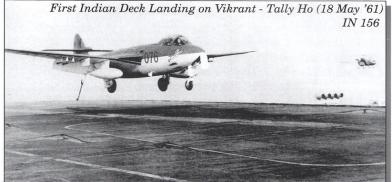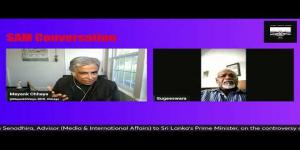Gogi Thapa: The sporting naval doctor who earned his wings
Surgeon-Captain DK (‘Gogi’) Thapa who passed away in Mumbai on Feb 13 was a rare combination of medical doctor and naval-aviator who carved an extraordinary professional trajectory in his inimitable, understated and gentle manner. He was 88 years

Surgeon-Captain DK (‘Gogi’) Thapa who passed away in Mumbai on Feb 13 was a rare combination of medical doctor and naval-aviator who carved an extraordinary professional trajectory in his inimitable, understated and gentle manner. He was 88 years.
He was commissioned in the Army Medical Corps (AMC) in 1956, and permanently seconded to the Indian Navy. He volunteered for flying and qualified as a pilot and was awarded his wings in 1960. He first flew the Vampire jet, and then moved to flying Sea Hawks – the fighter aircraft operating from the aircraft carrier INS Vikrant – and clocked 45 hours of flying the 'Hawks. This included acquiring the deck landing qualification (DLQ) on the carrier, a very coveted professional feather even for fighter pilots.
Thapa had the unique distinction of serving in two different appointments on board the carrier, first as the medical officer of the fighter squadron and subsequently as the ship’s principal medical officer (PMO). To further burnish his impressive skill-sets, he even captained the Indian Navy football team that defeated the Mohun Bagan team in 1962. Football fans of that period may recall the magnitude and excitement of this sporting achievement – the diminutive silent service pitted against the legendary Mohun Bagan!
Maha Vir Chakra winner and veteran naval-aviator, RAdm Santosh 'Gigi' Gupta, recalls: I first met ‘Gogi’ Thapa in 1960 in Coimbatore when he was posted at the naval air station, INS Hansa, in Sulur, Coimbatore. He was then flying the Vampire – an early version jet fighter. A year later, he joined Indian Naval Air Squadron (INAS) 300, and converted to the Sea Hawk, which was a carrier-borne jet, preparatory to DLQ, under the supervision of squadron commander and pioneering naval aviator – Lt Cdr RAJ ‘Andy’ Anderson. .
DLQ was the ‘holy grail’ of every naval aviator, but required tremendous flying skills and not everyone made the grade. In Thapa’s case, as a qualified doctor, he had undergone the rigours of basic flying training with the IAF, to earn the coveted flying badge or ‘wings’ and had then been posted as the Squadron Medical Officer (MO) of INAS 300.
When he wanted to have a shot at acquiring DLQ, he had to go through the full gamut of shore-based carrier training, along with much younger ‘regular’ aviators. Concurrently he had to carry out the onerous duties of Squadron MO – which required him to be a friend, philosopher and guide to highly stressed and often temperamental pilots. – and often be squash -partner and drinking-buddy at the bar to gain their confidence.
Between 1963 and 1968, Gogi and I served together on board INS Vikrant and the air station INS Hansa, which had moved from Sulur to its present location in Goa. We watched with great interest as Doc Thapa was put through the repetitive grind of scores of ‘dummy deck landings’ on the Hansa runway. This was to ensure that the tight carrier-landing circuit (flown at just 400 ft above the sea), would become second nature to the pilot and to prepare him for the ‘controlled crash’ that a deck-landing was reputed to be.
When Doc Thapa’s big day came, I happened to be the Mirror Control Officer (MCO) of INS Vikrant. The MCO’s job on the carrier is to watch the approaching aircraft through a telescopic sight and guide him, on radio, about his height and alignment with the glide-slope. In case of a faulty or dangerous approach, the MCO must instantly warn the pilot and the ship, so that the aircraft can ‘go around’ at a safe height and make another approach.
I was watching anxiously when Gogi and three other pilots came in for their DLQ on Vikrant. Being much older than the other pilots and having the least flying experience, this was a great personal challenge for Doc. But he kept his nerve, and, after a few attempts, which may have frightened him more than the onlookers, he managed to ‘hook-on’ for the first time. His confidence boosted, Doc was launched thrice by the steam-catapult and landed back, successfully, each time. With four deck landings under his belt, Gogi Thapa became the only DLQ Doctor east of Suez. This was a rare distinction.
Doc Thapa wore his wings with great pride, but was, at heart, a dedicated aviation-medicine specialist. He would be up in the wee hours of the morning for the first flying briefing on the carrier; keenly scanning each crew’s face for signs of fatigue or tension – early warning signs of an impending accident. In the carrier’s tense and hectic flying environment, any aircrew member could approach Thapa with his woes – physical, mental or emotional – and find a sympathetic listener and adviser.
In later years, laid up as a patient in INHS Asvini after a back operation, he was his usual fun and humorous self - quite belying the trauma he was undergoing. Gogi had many personal setbacks but remained stoic till the end.
Many of us have lost a dear friend.
(The writer is a veteran naval fighter pilot and Maha Vir Chakra awardee)














Post a Comment